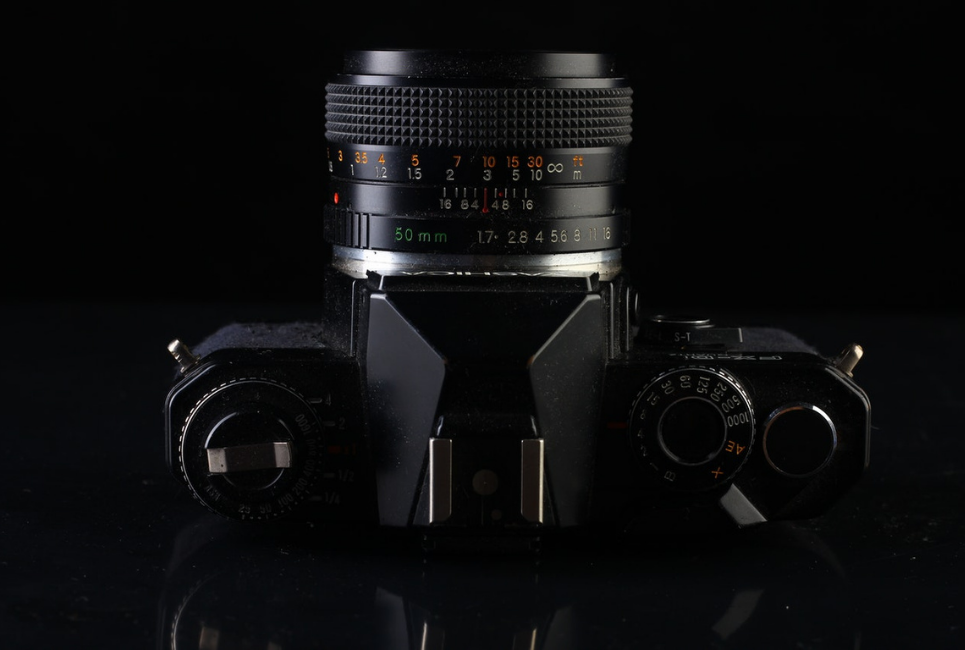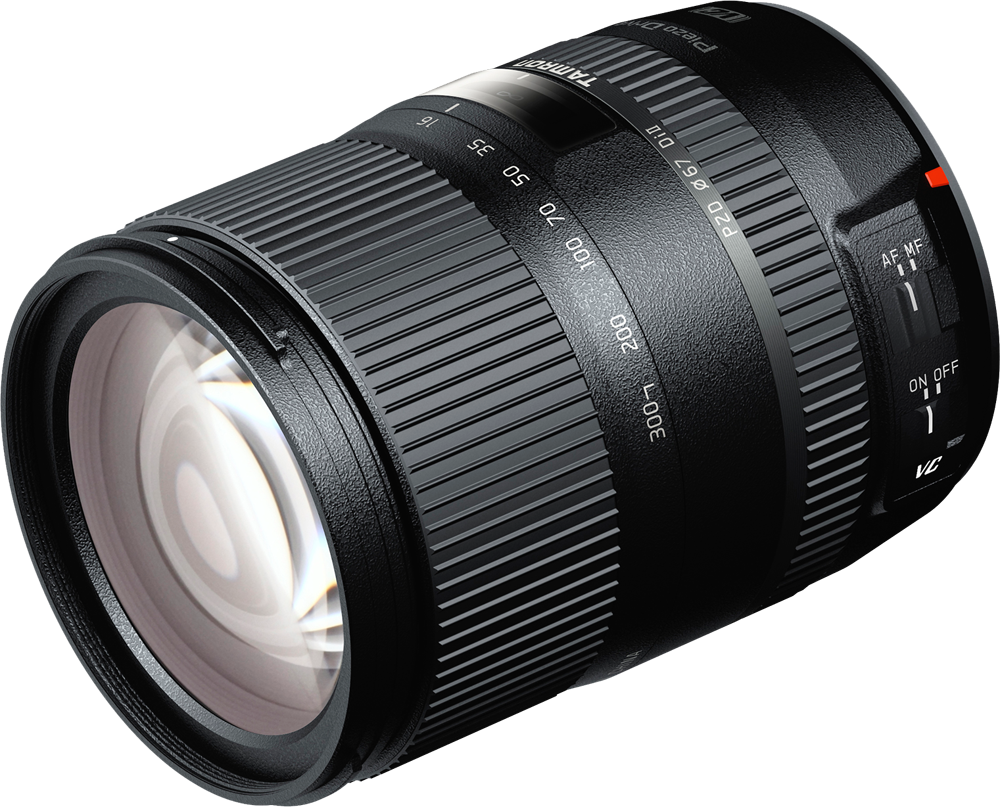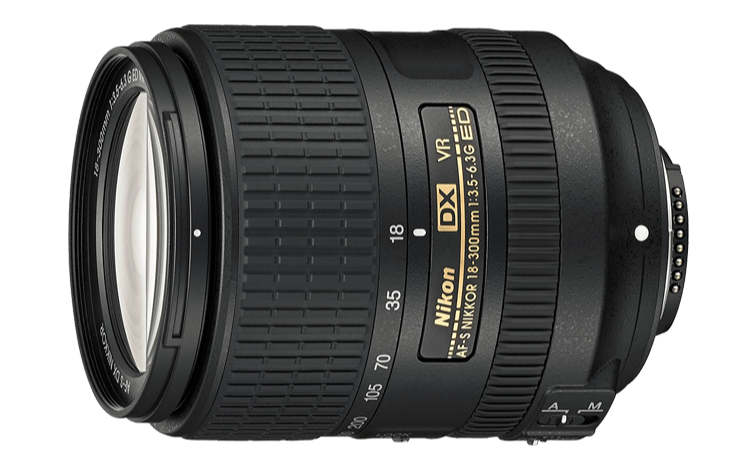Tamron 16-300mm vs Nikon 18-300mm: Which Is The Best Pick?
- Tamron 16-300mm vs Nikon 18-300mm: Which Is The Best Pick? - December 10, 2021
- Garmin VIRB vs GoPro: Which Brand Should You Trust? - December 9, 2021
- Canon G7X Mark II vs G9X Mark II: Which Camera Is Better? - December 9, 2021
Some lenses are perfect for whatever shot you have in mind. If you’re traveling or exploring the great outdoors, you can’t be bothered by heavy camera bags or even needing to switch out lenses. These situations call for a superzoom lens that offers you different focal lengths. And the Tamron 16-300mm and Nikon 18-300mm are two of your best bets.
But which one should you choose? Here are some of the notable differences and similarities between these two wonderful lenses.
Main Differences Between Tamron 16-300mm vs Nikon 18-300mm
The main differences between Tamron 16-300mm vs Nikon 18-300mm are:
- The Tamron lens is lighter, whereas the Nikon’s a bit heavier
- The Tamron 16-300mm is weatherproof, whereas the Nikon 18-300mm is not.
- The Tamron 16-300mm has a shorter minimum focal length at 16mm, whereas the Nikon 18-300mm’s 18mm.
- The Tamron lens has rounded aperture blades, whereas the Nikon lens doesn’t.
If you’re in the market for that perfect superzoom lens for your needs, read on as we talk about these two lenses. We’d explore everything you need to know about the Tamron 16-300mm and the Nikon 18-300mm.
Tamron 16-300mm F/3.5-6.3 Di II VC PZD Macro
The Tamron 16-300mm F/3.5-6.3 Di II VC PZD Macro gives you an ultra-wide-angle lens that can also do telephoto shots. At 16mm, this wide-angle lens can take in more of the scenery.
It can also help you get better perspective shots, with what’s closer to you will appear disproportionately bigger than something that’s further away. On the other hand, this Tamron lens also gives you powerful zooming with a 300mm super tele lens. That means that you can use these lenses for your nature photography when shooting wildlife or doing some astrography.
Flexibility: The Lens for Every Shot
The Tamron 16-300mm F/3.5-6.3 Di II VC PZD Macro offers a wide range of focal lengths and wider angles. You have a superzoom lens with a wide-angle capability.
The long range gives you the freedom to shoot objects near and far. You can take in as much detail as you’d like or pinpoint your focus to a smaller subject, even when it is far away.
Features You Should Know
- Longest focal length range at 16-300mm
- Quiet Piezo Drive mechanism for auto-focusing
- Vibration compensation acts as an excellent in-lens image stabilizer
- You can focus as close as 0.39 meters (15 inches)
- Maximum zoom magnification 0.34x
- One of the smallest cameras considering its focal range
- APS-C format
Tamron 16-300mm F/3.5-6.3 Di II VC PZD Macro: How It Performs
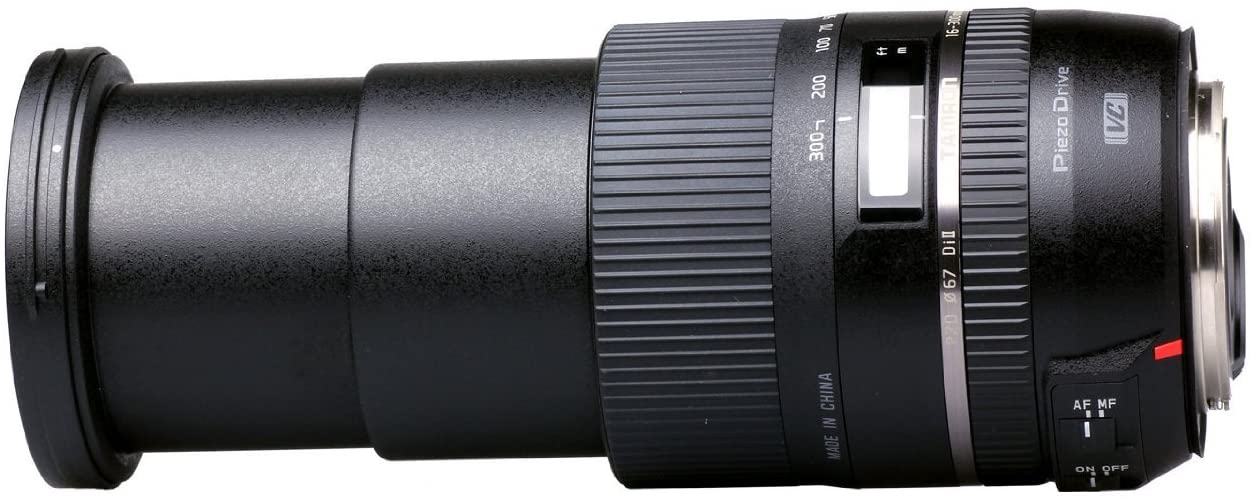
Wide-angle shots are very sharp with the Tamron 16-300mm F/3.5-6.3 Di II VC PZD Macro. You can use these lenses to get more of the scenery and have every detail recorded.
There may be some softness when you’re taking zoomed-in shots, but the sharpness is still excellent even when you’re at 200mm or longer. You will also experience some chromatic distortion, but that is to be expected with zoom lenses at their extreme lengths.
You might also be wondering how good this lens is with macro, as it is part of its name. Unfortunately, you may still need to buy a separate macro lens. This lens can focus close at around 3.5 inches (nine centimeters). And even at this distance, the edges can be a bit soft.
Expand your options with high-power zooming with a single lens covering 16mm to 300mm plus macro capability. Spanning an ultra-wide spectrum of focal lengths, the all-in-one zoom lens is a supremely versatile photographic tool.
Pros
- Tamron’s trademark “all-in-one” flexibility is evident in this camera
- 18.8x zoom ratio
- Very sharp when you’re shooting with short focal lengths
- Good enough close focusing
- It can withstand the conditions outdoors in any weather
- Lightweight, so you won’t have problems even if you shoot all day.
Cons
- Longer focal lengths result in lower sharpness and occasional blurs
- If you are zooming in too much, the autofocus can be wonky
Bottom Line
Tamron has patented the phrase “all-in-one” for lenses, and the Tamron 16-300mm F/3.5-6.3 Di II VC PZD Macro follows that tradition. You can use it to have superb wide-angle shots and then zero in on objects that are far away.
These lenses have lower image quality and higher F/numbers, but that is typical of a superzoom lens. But overall, you get a flexible lens that you can use in most shots that you need to take.
Nikon AF-S DX Nikkor 18-300mm f/3.5-5.6G ED VR
The Nikon AF-S DX Nikkor 18-300mm f/3.5-5.6G ED VR is made with glass, metal, and plastic, making it a solid 1.8 pounds (816 grams). But as far as the construction goes, it’s pretty solid and intuitive. There’s nothing groundbreaking there.
As with the Tamron lens, this Nikon AF-S DX Nikkor 18-300mm can be used to capture wide-angle shots as well as faraway objects. You can also use it to substitute for a macro lens as you can lock its focus up to 17.7 inches (45 centimeters).
You can also rely on its 0.32x magnification when you zoom in for a shot.
Features You Should Know
- VR II Image Stabilization reduces the effects of vibration and keeps your photos focused.
- Quiet autofocus with Nikon’s Silent Wave Motor
- You can switch from manual to automatic focusing without experiencing any lags.
- Super Integrated Coating helps keep the glass of these lenses safe
- Extra low dispersion glass for reducing chromatic distortions
Features maximum magnification of 0.32x and a minimum focusing distance of 1.6' Lens construction of 16 elements in 12 groups Works on FX-format cameras in DX crop mode. Note: Focal length decreases as the focus distance shortens.
How It Performs
The Nikon AF-S DX Nikkor 18-300mm f/3.5-5.6G ED VR tends to have the best image quality at the center of your photos, tapering a bit towards the edges. But at higher the focal length, more parts of your photos are softer, particularly at the edges.
As with most superzoom lenses, you should expect distortion to come into play. There’s also some vignetting and other problems that may be easily corrected.
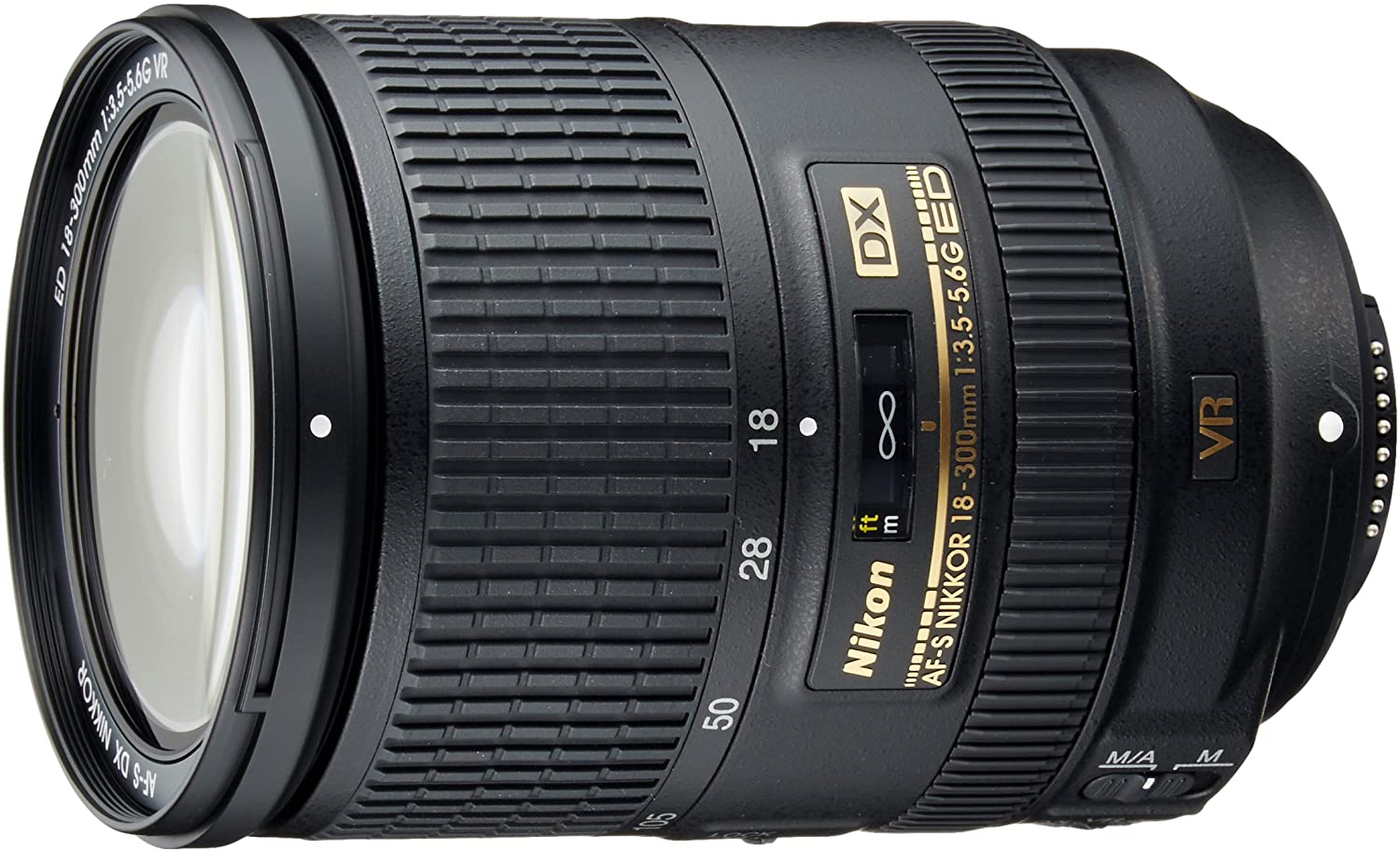
Pros
- A zoom range of 16.7x delivering sharp images at any point of this range
- Optical stabilization technology
- 1:3 macro magnification
Cons
- Suffers from a significant amount of distortion
- Your images tend to be softer at the edges
- Expensive
Bottom Line
As far as superzoom lens go, the Nikon AF-S DX Nikkor 18-300mm f/3.5-5.6G ED VR is an excellent choice. It helps you leave all other lenses at home when traveling and maybe even have a good substitute for your macro lenses.
Comparing the Tamron 16-300mm and Nikon 18-300mm
The Tamron 16-300mm and Nikon 18-300mm both claim to be all-in-one lenses. And for the most part, the good news is that they deliver on these promises.
Between these two, they share the following characteristics:
- Both of these cameras have a metal mount and a Maximum focal length of 300mm
- Lens hood included
- Has built-in stabilizer
- Both have an aperture of f/3.5
- Silent focus motors and full-time focus
But there are also some differences between these two, and these are the criteria that can sway you to select one lens over the other.
Differences between the Tamron 16-300mm and Nikon 18-300mm
Lenses like the Tamron 16-300mm and Nikon 18-300mm are popular among travelers and tourists who don’t want to carry a lot of gear. As such, you can expect these lenses to be used outdoors when you’re traveling.
Whether it’s a hike through nature or exploring a new city, you will appreciate the Tamron 16-300mm more because it’s more lightweight and weatherproof.
Tamron’s lens weighs 1.2 pounds (540 grams), a good 0.63 pounds (290 grams) less than the 1.8 pounds (830 grams) of the Nikon lens. The Tamron 16-300mm also has a shorter minimum focal length of 16mm, which allows you to get more of the lovely scenery into your frame.
And if there’s something that that you’d like to shoot up close, then Tamron does a good job of letting you put your macro lens away.
Optical Zoom and Other Camera Things
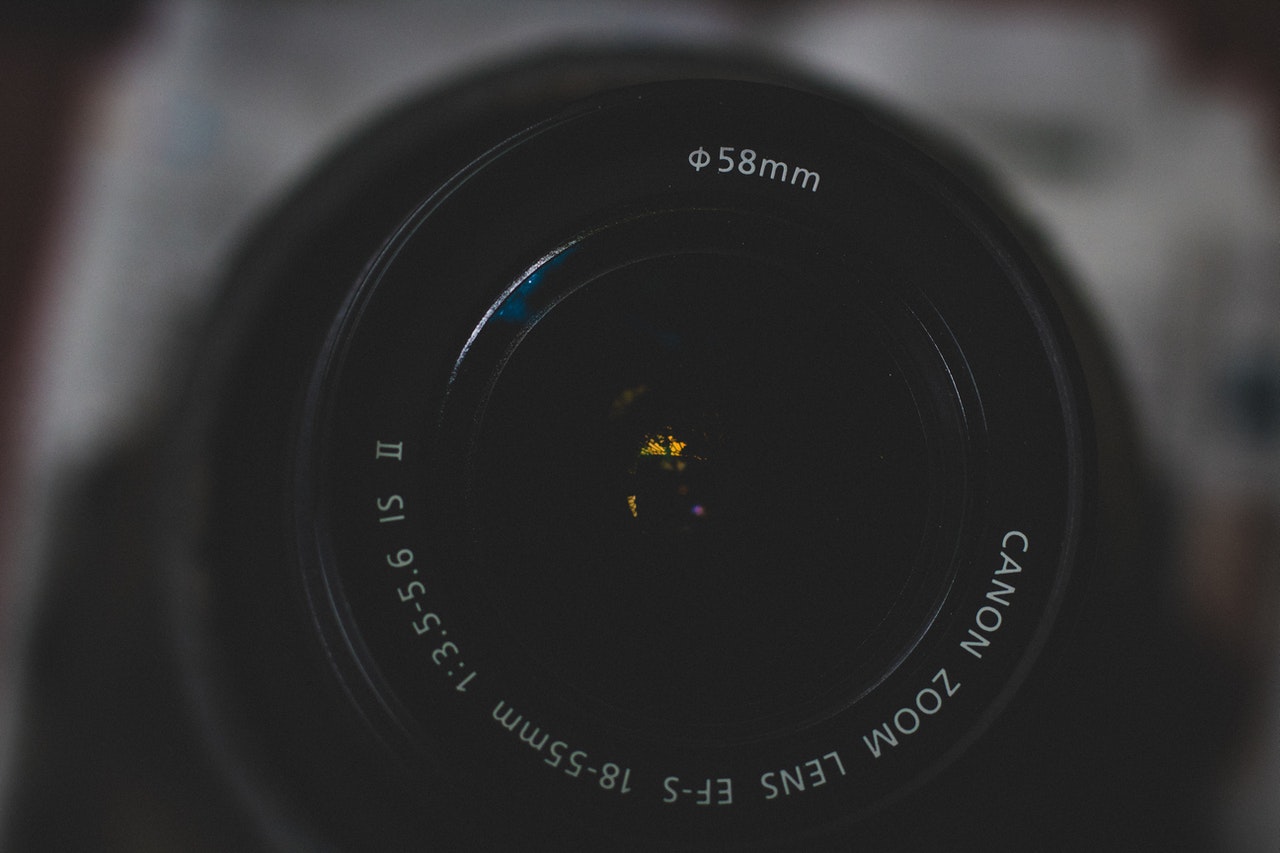
When it comes to which lens is more flexible, the Tamron lens has a 19x zoom range, while the Nikon only has 16.7. That means that the Tamron lens allows you to be more flexible with your shots and get further away from objects.
Meanwhile, the Nikon 18-300mm has nine aperture blades that help to control just how much light reaches the camera’s sensors. Tamron only has seven.
However, Tamron has rounded aperture blades that help give your photos a better look when it comes to those areas that are not in focus. So if you plan on shooting bokeh, forget the Nikon lens.
Tamron also allows you to get closer to your subject with a minimum focus distance of 15.4 inches (39 centimeters), about 2.4 inches (six centimeters) closer than the Nikon lens.
Side-by-Side Comparison: Tamron 16-300mm vs. Nikon 18-300mm
To make it easier for you to see the differences between these two lenses, here’s a comparison table that details just that:
| Tamron | Nikkon | |
| Weight (grams) | 540 | 830 |
| Weatherproof | Yes | No |
| Minimum focal length | 16mm | 18mm |
| It can be used for macro shots | Yes | no |
| Maximum angle of view (degrees) | 82.2 | 76 |
| Magnification | 0.34x | 0.32x |
| Optical zoom | 19x | 16.7x |
| Minimum angle of view (degrees) | 5.3 | 5 |
| Aperture blades | 7 | 9 |
| Widest aperture at 300mm | 6.3f | 5.6f |
| Smallest aperture at 300mm | 40f | 32f |
| Rounded aperture blades | Yes | No |
Alternatives to Both Tamron 16-300mm F/3.5-6.3 Di II VC PZD Macro and Nikon AF-S DX Nikkor 18-300mm f/3.5-5.6G ED VR
The superzoom lens market is a crowded one. Aside from Tamron and Nikon, other major players have their own offerings. If you’d like to find different lenses that are similar to these two, look no further than:
- Canon EF-S 18-200mm f/3.5-5.6 IS Lens
- Sony SAL18250 Alpha DT 18-250mm f/3.5-6.3 High Magnification Zoom Lens
- Sigma 18-300mm f/3.5-6.3 DC Macro OS HSM
Canon EF-S 18-200mm f/3.5-5.6 IS Lens
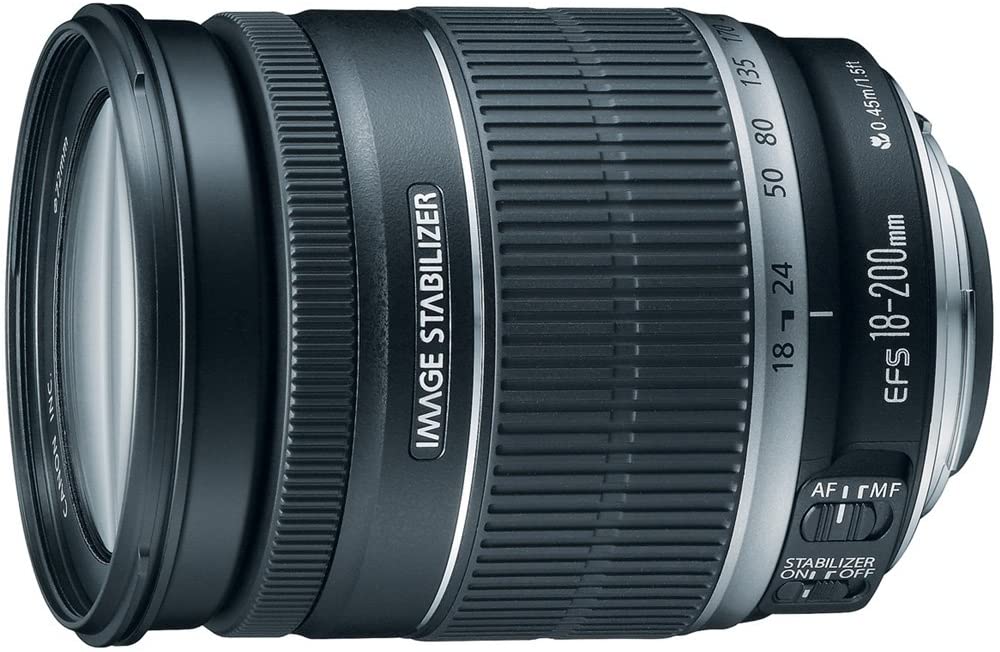
The Canon EF-S 18-200mm f/3.5-5.6 IS Lens is another superzoom camera that can give you wide shots to zoomed-in images from 18 to 200mm. It measures 3.09 by 4.02 inches (78.6 by 102 millimeters) and weighs only 1.31 pounds (595 grams).
It is compatible with APS-C cameras with an angle of view of 74 degrees and 20 minutes to 7 degrees and 50 minutes. The minimum focus distance is 1.48 inches (45 centimeters). Maximum magnification is rated at 0.24x and has six rounded diaphragm blades.
Bottom Line: Canon EF-S 18-200mm f/3.5-5.6 IS Lens
The Canon EF-S 18-200mm f/3.5-5.6 IS Lens delivers a wide zoom range without the bulk. But while the autofocus is a great and lightweight lens, the motor is noisy and slow. This can affect your camera’s performance in low-light situations.
It also doesn’t have an included lens hood, and barrel distortion is very noticeable when you’re shooting at 18mm.
Compact, slight weight and a wide magnification range - this standard zoom lens features a wide focal length range from normal to telephoto equivalent to 29-320mm in the 35mm format.
Sony SAL18250 Alpha DT 18-250mm f/3.5-6.3 High Magnification Zoom Lens
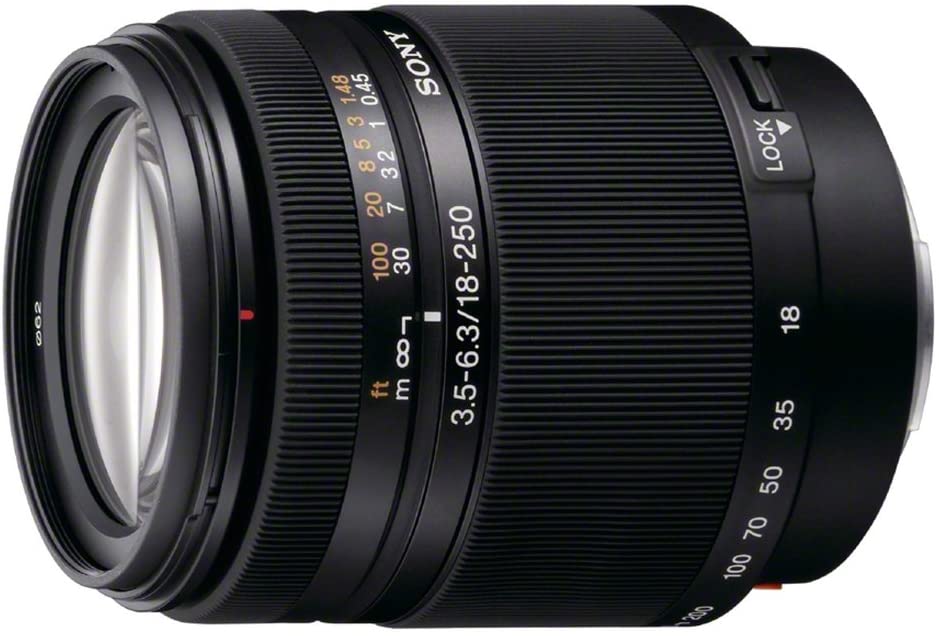
The Sony SAL18250 Alpha DT 18-250mm f/3.5-6.3 High Magnification Zoom Lens gives you 0.29x maximum magnification of 0.29x and has a minimum focus distance of 1.48 inches (45 centimeters). This lens measures 2.95 by 3.39 inches (75 by 88 millimeters) and weighs 15.52 ounces (440 grams).
You can use these with Sony A APS-C cameras.
The Bottom Line: Sony SAL18250 Alpha DT 18-250mm f/3.5-6.3 High Magnification Zoom Lens
This lens is compact yet can surprise you with how flexible it is. It delivers a 14x zooming range, yet it is very lightweight.
You should know, however, that you should only use this with Sony’s SLT cameras. There are also problems with chromatic aberration and sharpness when you zoom it.
This lens is an excellent option when your need a bit more "reach" at the long end that can make a significant difference if you're shooting sports or wildlife.
Sigma 18-300mm f/3.5-6.3 DC Macro OS HSM
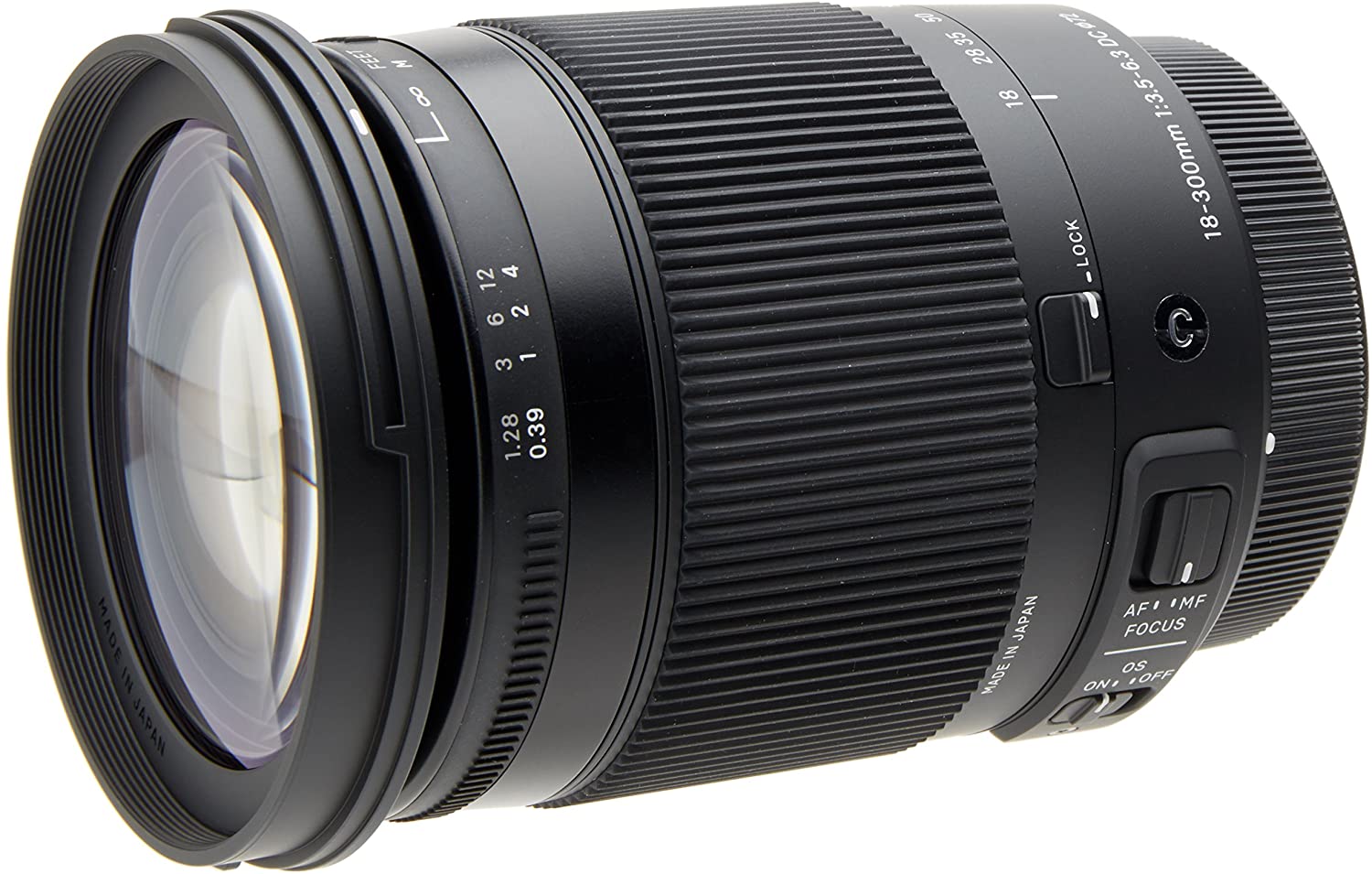
The Sigma 18-300mm f/3.5-6.3 DC Macro OS HSM measures 3.11 by 4.0 inches (79 by 101.5 millimeters)and weighs 1.3 pounds (585 grams). This lens has a focal length range of 18 to 300 millimeters, making it one of the most flexible all-in-one lenses.
The Bottom Line: Sigma 18-300mm f/3.5-6.3 DC Macro OS HSM
The Sigma 18-300mm f/3.5-6.3 DC Macro OS HSM gives you a 16.7x zoom range and a 1:3 macro reproduction. You get fast and reliable image stabilization, and all that goodness is packed in a compact body.
However, it does have detectable distortion and corners that are a wee bit darker than other lenses.
The Sigma 18-300mm 3.5-6.3 DC HSM OS Macro is another impressive addition to the Sigma Global Vision Contemporary line.
Side-by-Side Comparison of These Alternatives
No lens beats Tamron’s 16-300mm with its 0.34x magnification range among these three alternatives. The Sigma 18-300mm with 0.33x magnification, while the Nikon 18-300mm only has 0.32x.
Nikon’s lens wins when it comes to the number of aperture lenses with nine. Tamron, Sony, and Sigma all have seven aperture blades, while Canon only has six.
Sony DT is the only one that doesn’t feature automatic image stabilization. Fortunately, all lenses offer an autofocus function.
Among these three, if you’re looking for the most affordable lens with higher magnification, you won’t go wrong with the Sigma 18-300mm. Both Sony and Canon belong to the more expensive tier.
If you’re doing a lot of outdoor treks or traveling, and you really don’t need too many zoomed-in shots, the Sony DT 18-250mm is perfect for you. Meanwhile, Sigma 18-300mm is affordable and has a longer focal length range.
| Names | Canon 18-200mm | Sony DT 18-250mm | Sigma 18-300mm |
| Dimensions (millimeters) | 78.6 by 102 | 75 by 86 | 79 by 101.5 |
| Weight | 595 | 440 | 585 |
| Price | $699.99 | $648.00 | $579.00 |
| Autofocus | Yes | Yes | Yes |
| Filter size (millimeters) | 72 | 62 | 72 |
| Focal length | 18 to 200mm | 18 to 250mm | 18 to 300mm |
| Image stabilization | Yes | None | Yes |
| Maximum aperture | f/3.5 to 5.6 | f/3.5 to 6.3 | f/3.5 to 6.3 |
| Maximum magnification | 0.24x | 0.29x | 0.33x |
| Minimum aperture | f/22 to 36 | f/22 to 40 | f/22 |
| Minimum focus distance (centimeters) | 45 | 45 | 39 |
| Rounded diaphragm blades | 6 | 7 | 7 |
Tamron 16-300mm or Nikon 18-300mm: Which Should You Buy?
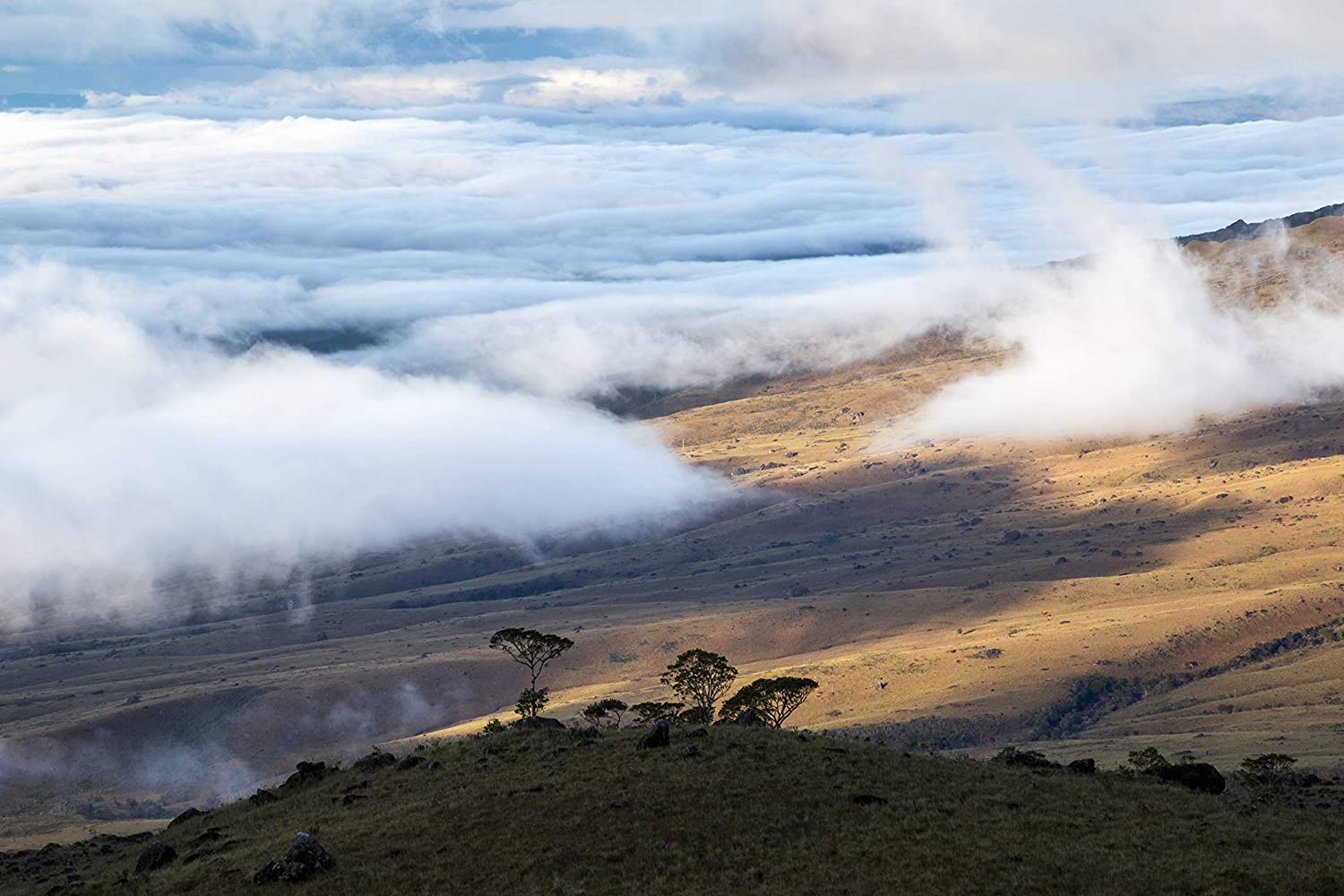
For the most part, you can go with either the Tamron 16-300mm or the Nikon 18-300mm. Both of these lenses can do it all, from getting more of the scenery into the frame to getting close-up shots of things that are far away. Regardless of which one you buy, you will be working with a lens that allows you to shoot anything without too much shaking registering in the photos. What’s more, they both work silently.
However, little things make the Tamron 16-300mm lens better than Nikon’s. For one, Tamron offers better macros and has a wider angle. It’s also more lightweight. Tamron’s lens also has a higher zoom range, rounded aperture blades and lets you get closer to your subjects for those close-up shots.
FAQs
Answer: The Tamron 16-300mm and Nikon 18-300mm lenses we are talking about here fall under the superzoom category. As they are considered all in one lens, you can use them to shoot photos with wide angles or zoom into to get a distant object to fill up your frame.
That means that if you’re traveling light and would like to make sure that you won’t miss out on a good shot, these lenses are the best ones to bring with you. The average weight of lenses today is around 1.8 pounds (800 grams). Granting that you need to bring at least three lenses to cover any shot they’d like to make, that’s an easy 5.3 pounds (2.4 kilograms. Not to mention that it’s going to be a lot of hassle to constantly switch out lenses while you’re in a busy tourist trap.
What’s more, there are other benefits that you can enjoy when you buy a superzoom lens. It’s generally less expensive than having to buy a number of lenses to cover the range of focal lengths that superzooms give you. Often, they cost less than $600. Plus, it allows you to bring a smaller camera bag, as they often measure about three by four inches (7.6 to 10.2 centimeters). Having a wide-angle lens and telephoto lens with you will take up too much space.
Answer: While flexibility in focal lengths is the biggest selling point of a superzoom lens, you should know some tradeoffs. For one, these lenses are not as sharp as other lenses, no matter what focal length you use. There will always be some degree of distortions and aberrations, and these all have their own respective solutions.
That means that these lenses are certainly not for beginners. And you will have to use a superzoom lens for quite some time to know how to correct these distortions. Further, these lenses can be a bit slower than professional zoom lenses. And no matter what the marketing materials say, these lenses are often not true macros lenses.
Answer: If you’re not sold on either Tamron 16-300mm or Nikon 18-300mm, here are some options:
• Sigma 18-300mm f/3.5-6.3 Macro OS HSM C combines small size, fast focusing speeds, and a reasonable price to give you a serious option. Features optical stabilization, the Hyper Sonic Motor AF System, one SLD, and four FLD elements.
• Olympus M.Zuiko Digital 12-200mm f/3.5-6.3 has a zoom range of 16.6x zoom and is both dust and splashproof. On top of taking shots of objects that are far away, you can also use this for regular, very wide-angle shots.
• Sigma 18-250mm f/3.5-6.3 DC Macro OS HSM is equivalent to 27-375mm on APS-C cameras. It offers four stops of image stabilization and a micro-motor autofocus motor.
